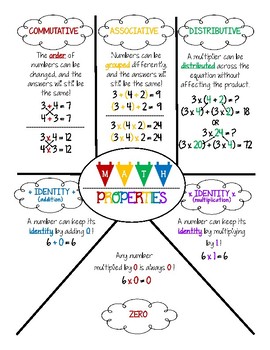MATH Properties of Multiplication and Addition Anchor Chart or Reference Sheet
Write Noise
416 Followers
Grade Levels
3rd - 5th
Subjects
Standards
CCSS3.OA.B.5
CCSS4.OA.A.2
Formats Included
- PDF
Pages
1 page
Write Noise
416 Followers
What educators are saying
I enlarged this reference to make a big anchor chart. It acts as a great reminder to my students about the properties. This saved me time and is a great reference and very colorful.
This was a great resource to use with students' interactive notebooks. It was a fun way to do a quick review.
Description
This is a colorful anchor chart I created and printed poster-sized to display in my room and paper-sized for students to include in their math binders.
Total Pages
1 page
Answer Key
N/A
Teaching Duration
2 Weeks
Report this resource to TPT
Reported resources will be reviewed by our team. Report this resource to let us know if this resource violates TPT’s content guidelines.
Standards
to see state-specific standards (only available in the US).
CCSS3.OA.B.5
Apply properties of operations as strategies to multiply and divide. Examples: If 6 × 4 = 24 is known, then 4 × 6 = 24 is also known. (Commutative property of multiplication.) 3 × 5 × 2 can be found by 3 × 5 = 15, then 15 × 2 = 30, or by 5 × 2 = 10, then 3 × 10 = 30. (Associative property of multiplication.) Knowing that 8 × 5 = 40 and 8 × 2 = 16, one can find 8 × 7 as 8 × (5 + 2) = (8 × 5) + (8 × 2) = 40 + 16 = 56. (Distributive property.)
CCSS4.OA.A.2
Multiply or divide to solve word problems involving multiplicative comparison, e.g., by using drawings and equations with a symbol for the unknown number to represent the problem, distinguishing multiplicative comparison from additive comparison.


